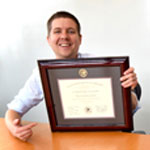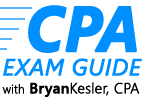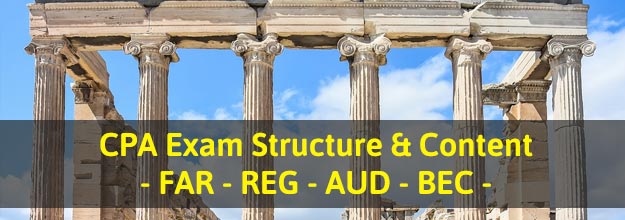- ✎ Updated
- ➫ by Bryan Kesler, CPA

ABOUT THE AUTHOR:
Bryan Kesler, CPA is a CPA Practice Advisor Top 20 Under 40, Licensed Certified Public Accountant, and founder of Kesler CPA Review, Community and Mentorship Platform.
- ❯ CPA Exam Study Tips

Ready to become a certified public accountant? You are in the right place to learn exactly what is tested on this comprehensive Uniform CPA examination!
Now that you have met the education requirements from both undergraduate and graduate classes and met the residency and age requirements for your states you are ready to to apply to sit for the CPA exam.
But before you apply, you should familiarize yourself with exactly what is tested on the exam so there are NO surprises.
Let's get started!
What Is Tested On The CPA Exam?
CPA Exam Format, Content, & Structure
The CPA Exam is broken down into three CORE sections (pass all three) and three DISCIPLINES (pick and pass only one).
Each section is administered by the AICPA for a total of 16 hours tested. Four hours per section.
The three CORE sections are Financial Accounting and Reporting (FAR), Regulation (REG), Auditing and Attestation (AUD).
The three DISCIPLINES are Business Analysis and Reporting (BAR), Information Systems and Controls (ISC) and Tax Compliance and Planning (TCP).
In order to qualify to become a licensed CPA, you must pass all three CORE sections and pick and pass one DISCIPLINE section all within 30 months.
The authoritative exam outline is called the AICPA blueprints and is made up of the areas, topics, sub-topics and representative tasks that each CPA candidate is expected to be able to complete.
Each represenative task is also mapped to a set Skill Level based on Bloom's taxonomy which is how you know what type of question (multiple choice or task-based simulation) you will be asked by task.
What are the six sections of the CPA exam?
-
Business Analysis and Reporting (BAR)
-
Information Systems and Controls (ISC)
Types Of Questions On CPA Exam
There are two types of questions asked on the CPA Exam. It's important to understand what is expected of you when answering these questions and understand the differences between each type.
1) Multiple Choice Questions
For each section of the CPA exam you will be given 2 testlets of multiple choice questions. Each question will have 4 possible answers that you can select from.
These multiple choice questions are designed to test your basic remembering and understanding learning skills.
2) Task-Based Simulations
All six sections of the CPA exam now have TBS or task-based simulations. These questions are designed to re-create real world scenarios you will experience as a CPA.
You will be required to show you understand the topics and concepts asked and to prove you are able to research accounting questions for clients or customers.
These types of questions will test your higher order learning skills such as Analysis and Evaluation.
Format Of The CPA Exam By Parts
Each section of the CPA exam is formatted slightly differently. Here is a breakdown of each section by format so you can know what to expect and how to budget your time on CPA exam day.
FAR, REG & AUD CORE Sections + BAR, TCP & ISC DISCIPLINE Formats
Financial Accounting & Reporting (FAR) , Regulation (REG) and Auditing & Attestation (AUD) are all formatted similarly. You can expect to have 50% of your exam be multiple choice and the other 50% be task-based simulations (TBS).
For each of these sections you will have 2 testlets of multiple choice as follows:
-
FAR has 25 multiple choice questions per testlet
-
REG has 36 multiple choice questions per testlet
-
AUD has 39 multiple choice questions per testlet
-
BAR has 25 multiple choice questions per testlet
-
TCP has 34 multiple choice questions per testlet
-
ISC has 41 multiple choice questions per testlet
Following your multiple choice testlets you will have 3 additional testlets of Task-Based Simulations (TBS) which will contain the following:
-
FAR has 7 (2 | 3 | 2 per testlet) task-based simulations
-
REG has 8 (2 | 3 | 3 per testlet) task-based simulations
-
AUD has 7 (2 | 3 | 2 per testlet) task-based simulations
-
BAR has 7 (2 | 3 | 2 per testlet) task-based simulations
-
TCP has 7 (2 | 3 | 2 per testlet) task-based simulations
-
ISC has 6 (1 | 3 | 2 per testlet) task-based simulations
What Is The Tested On FAR
Financial Accounting and Reporting is the largest section of the CPA exam and comprehensively covers many different areas of general accounting and reporting.
FAR requires CPA candidates have a strong understanding of US GAAP, primarily covering concepts and standards for financial statements, items on financial statements, various types of transactions, governmental and not for profit accounting standards and reporting for governmental entities.
CPA Candidates will also be expected to apply these concepts and standards as required by any CPA.
FAR is made up of the following primary topics:
-
Conceptual Framework and Financial Reporting (25-35%)
-
Select Financial Statements Accounts (30-40%)
-
Select Transactions (20%-30%)
-
State and Local Governments (5%-15%)
Conceptual Framework and Financial Reporting (25-35%)
| 1)
Conceptual framework and standard-setting |
2) General-purpose financial statements: for-profit business entities | 3) General-purpose financial statements: nongovernmental, not-for-profit entities |
| 4) Public company reporting topics | 5) Financial statements of employee benefit plans | 6) Special purpose frameworks |
Select Financial Statements Accounts (30-40%)
| Cash and cash equivalents | Trade receivables | Inventory |
| Property, plant and equipment | Investments | Intangible assets |
| Payables and accrued liabilities | Long-term debt | Equity |
| Revenue recognition | Compensation and benefits | Income taxes |
Select Transactions (20%-30%)
| Accounting changes and error corrections | Business combinations | Contingencies and commitments |
| Derivatives and hedge accounting | Foreign currency transactions and translation | Leases |
| Nonreciprocal transfers | Research and development costs | Software costs |
| Subsequent events | Fair value measurements | Differences between IFRS and U.S. GAAP |
State and Local Governments (5%-15%)
| State and local government concepts | Format and content of the Comprehensive Annual Financial Report (CAFR) |
| Deriving government-wide financial statements and reconciliation requirements | Typical items and specific types of transactions and events in governmental entity financial statements |
How Much Time Do You Have To Complete FAR and How Is It Weighted?
You are given 4 hours to complete the exam. When being graded your exam will be weighted as follows:
-
50% Multiple Choice
-
50% Simulations
What Is The Tested On REG
Regulation is the 2nd largest section of the CPA exam and comprehensively covers many different areas of taxes and business law.
Regulation is made up of the following topics:
-
Ethics, Professional Responsibilities, and Federal Tax Procedures (10-20%)
-
Business law (10-20%)
-
Federal Taxation (60-80%)
Ethics, Professional Responsibilities, and Federal Tax Procedures (10-20%)
| Ethics and responsibilities in tax practice | Licensing and disciplinary systems |
| Federal tax procedures | Legal duties and responsibilities |
Business Law (10-20%)
| Contracts | Agency |
| Business structure | Debtor-creditor relationships |
| Government regulation of business |
Federal Taxation (60-80%)
| Federal taxation of individuals | Federal taxation of entities |
| Federal taxation of property transactions |
How Much Time Do You Have To Complete FAR and How Is It Weighted?
You are given 3 hours to complete the exam. When being graded your exam will be weighted as follows:
-
50% Multiple Choice
-
50% Simulations
What Is The Tested On AUD
Auditing and Attestation (AUD) is considered by many to be the most difficult section of the CPA exam.
It comprehensively covers many different areas of auditing and attestation as follows:
Auditing and Attestation is made up of the following topics:
-
Ethics, Professional Responsibilities and General Principles (15-25%)
-
Assessing Risk and Developing a Planned Response (20-30%)
-
Performing Further Procedures and Obtaining Evidence (30-40%)
-
Forming Conclusions and Reporting (15-25%)
Ethics, Professional Responsibilities and General Principles (15-25%)
| Nature and Scope of Audit and Non-Audit Engagements | Ethics, Independence and Professional Conduct | Terms of Engagement for Audit and Non-Audit Engagements |
| Requirements for Engagements Documentation | Communication with Management and Those Charged with Governance | Communication with Component Auditors and Parties Other Than Management and Those Charge with Governance |
| A Firm’s System of Quality Control, Including Quality Control at the Engagement Level |
Assessing Risk and Developing a Planned Response (20-30%)
| Planning an Engagement | Understanding an Entity and Its Environment | Understanding an Entity’s Internal Control |
| Assessing Risks Due to Fraud | Identifying and Assessing the Risk of Material Misstatement and Planning Further Procedures Responsive to Identified Risks | Materiality |
| Planning for and using the Work of Others, Including Group Audits, the Internal Audit Function and the Work of a Specialist | Specific Areas of Audit Risk |
Performing Further Procedures and Obtaining Evidence (30-40%)
| Understanding Sufficient Appropriate Audit Evidence | Sampling Techniques | Performing Specific Procedures to Obtain Evidence |
| Specific Matters that Require Individual Attention | Misstatements and Internal Control Deficiencies | Written Representations |
| Subsequent Events and Subsequently Discovered Facts |
Forming Conclusions and Reporting (15-25%)
| Reports On Auditing Engagements | Reports On Attestation Engagements | Accounting and Review Service Engagements |
| Reporting On Compliance | Other Reporting Considerations |
How Much Time Do You Have To Complete AUD and How Is It Weighted?
You are given 4 hours to complete the exam. When being graded your exam will be weighted as follows:
-
50% Multiple Choice
-
50% Simulations
What Is The Tested On BAR
COMING SOON
What Is The Tested On TCP
COMING SOON
What Is The Tested On ISC
COMING SOON
Ethics Exam
Depending on your state, you may be required to complete Ethics training in order to become a licensed CPA. The most popular Ethics Course is the AICPA's Professional Ethics: The AICPA's Comprehensive Course.
It is an open book self study CPE program that can be completed at any point in your exam.
NOTE: Not all states require you to take the CPA exam, and some require specific Ethics exams other than the exam mentioned above.
In general, you are required to pass your ethics exam within two years preceding initially applying for your CPA certificate.
Next Step In The CPA Exam Process...
Before you get overwhelmed by the massive amount of information tested on the CPA exam, let's discuss what the CPA exam can do for your career.
By passing the CPA exam you automatically set yourself apart from all other accountants.
There are approximately 646,000 active CPA in the United States, so by passing the CPA exam you are part of an elite group of accountants.
The CPA exam is also a universally recognized certificate which will make transitioning to a different career or industry much easier than if you were not a CPA.
There are other non-tangible benefits to becoming a CPA but the biggest tangible result is the monetary advantage you will have over your peers.
It has been shown that CPA's typically make $1,000,000+ over their careers than their non-CPA counterpart.
If you want to be the best accountant you can be, then passing the CPA exam is a no brainer.
Your next step needs to be find the best CPA review course for you.
This is going to be a significant investment and the last thing you want to do is "cheap" out on a course that doesn't give you the tools you need to pass the CPA exam on your first try.
Take our CPA Exam Study Personality Quiz to get started
OR
You can visit our Top CPA Review Courses Comparison page to determine all your options.
Once you have found a CPA review course then it's time to sign up for the CPA exam and start learning HOW to study for the CPA exam.
Here's my step by step CPA exam application process and 21 study tips and strategies to get you started!
Finally, if you have a fear of failure (or have failed a section of the CPA exam) here are my best strategies you can steal to help you overcome failing the CPA exam.
 ABOUT THE AUTHOR:
ABOUT THE AUTHOR:
Bryan Kesler, CPA is the founder of Kesler CPA Review & Ultimate CPA Exam Guide which earned him a spot on CPA Practice Advisor's Top 20 Under 40.
He has helped thousands of CPA candidates pass the CPA exam since 2013. You can contact him via email bryan@cpaexamguide.com


